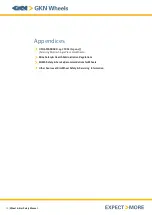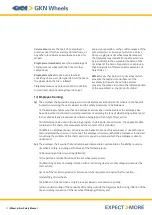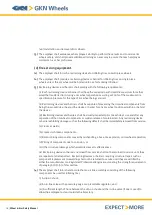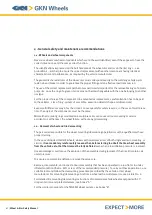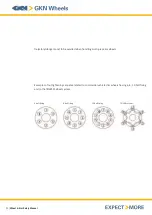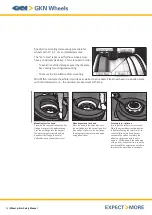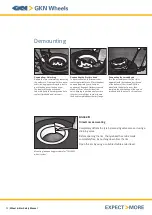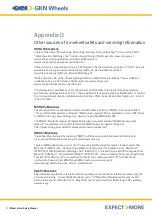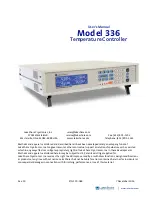
88 |
Wheel & Rim Safety Manual
2.3 - Identify a damaged rim/wheel
Periodically check the wheel conditions: a complete cleaning of all surfaces before inspection will help in
finding more easily and surely possible defects.
Check closely all components after removal, to ensure that they are in good condition and look for any
possible non-conformity -- see picture No. 3.
In order to avoid damage to tires, during mounting or while in use, any sharp edges, burrs or uneven
areas which might have occurred during service should be deburred and covered with a suitable paint to
protect against corrosion.
The matching surfaces between the wheel and the vehicle as well as those of the components in a multi-
piece rim must be cleaned and protected against corrosion, also.
The wheel as a safety part, must not show fractures, deformations, distortions, severe corrosion,
excessive wear, buckled, or twisted rings (where existing) or other similar defects. Such pieces must not
be reused, but destroyed and scrapped.
Also in the event of a suspected damage or if in doubt about the suitability of a wheel/rim component,
the involved part must be replaced.
The replacement has to be carried out with new pieces having completely identical characteristics.
In the event that the correct removable rings are not available, a new complete rim/wheel should be fitted.
Typical defects that require the parts replacement are:
·
cracks in the wheel disc face, in particular the bolt holes area and the ventilation
holes can be concerned
·
deformations or abnormal imprints in the seats of the bolts/studs fixings
·
leaks in tubeless tires derived by micro-cracks in the rim or by wear and tear marks
on the rim-tire matching surface
·
bent rim flanges (generally due to impacts against obstacles)
·
circumferential cracks on the rear flange or at the gutter in the base of multipiece rims
·
broken, buckled side/kombi ring or excessive corrosion on rings of multipiece rims
·
twisted rings, in particular lock and 'kombi' rings
It is not allowed to perform any technical modification on the wheel.
The repair of a damaged rim or disc by heating, by welding, by addition or removal of material is
absolutely forbidden.
No guarantee on repaired parts is acceptable since such changes may introduce additional stresses in
critical, high stressed areas.
Wear on rim flanges (top of the flanges) can be tolerated up to a maximum of 10 % of the initial thickness
of the rim material.


